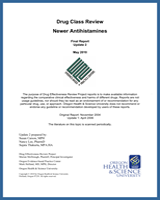NCBI Bookshelf. A service of the National Library of Medicine, National Institutes of Health.
This publication is provided for historical reference only and the information may be out of date.
Antihistamines inhibit the effects of histamine at H1 receptors. They have a number of clinical indications including allergic conditions (e.g., rhinitis, dermatoses, atopic dermatitis, contact dermatitis, allergic conjunctivitis, hypersensitivity reactions to drugs, mild transfusion reactions, and urticaria), chronic idiopathic urticaria (CIU), motion sickness, vertigo, and insomnia. First-generation antihistamines are highly lipophilic and therefore readily cross the blood-brain barrier, contributing to adverse central nervous system effects, including sedation, drowsiness, and decreased cognitive processing. Newer antihistamines were developed to decrease the adverse effects of first generation drug. "Second generation" antihistamines have higher specificity for binding to H1 receptors, lower affinity for non-histamine receptors, and are lipo-phobic (thus have poor penetration of the blood brain barrier). Third generation antihistamines are natural metabolites of second generation drugs, developed with the goal of improving clinical efficacy and minimizing side-effects. The purpose of this review was to compare the efficacy, effectiveness, and adverse effects of newer antihistamines in both adult and pediatric populations.
The following key questions guided this review:
- For outpatients with seasonal or perennial allergic rhinitis or urticaria, do newer antihistamines differ in effectiveness?
- For outpatients with seasonal or perennial allergic rhinitis or urticaria, do newer antihistamines differ in safety or adverse effects?
- Are there subgroups of patients based on demographics (age, racial groups, gender), other medications (drug-drug interactions), comorbidities (drug-disease interactions), or pregnancy for which one newer antihistamine is more effective or associated with fewer adverse effects?
Contents
- Introduction
- Methods
- Results
- Key Question 1. For outpatients with SAR, PAR, or urticaria, do newer antihistamines differ in effectiveness?
- Key Question 2. For outpatients with SAR, PAR or CIU do newer antihistamines differ in safety or adverse effects?
- Adverse Events
- Key Question 3. Are there subgroups of patients based on demographics (age, racial groups, gender), concomitant medications (drug-drug interactions), co-morbidities (drug-disease interactions or pregnancy), for which one newer antihistamine is more effective or associated with fewer adverse effects?
- Summary
- Discussion
- References
- Appendixes
- Evidence Tables
Oregon Evidence-based Practice Center, Oregon Health & Science University, Mark Helfand, MD, MPH, Director
The funding source, the Center for Evidence-based Policy, is supported by 17 organizations, including 15 state Medicaid programs. These organizations selected the topic and had input into the Key Questions for this review. The content and conclusions of the review are entirely determined by the Evidence-based Practice Center researchers. The authors of this report have no financial interest in any company that makes or distributes the products reviewed in this report.
Suggested citation:
Drug Class Review on Newer Antihistimines. Final Report Update 1. http://derp.ohsu.edu/about/final-products.cfm
The purpose of this report is to make available information regarding the comparative effectiveness and safety profiles of different drugs within pharmaceutical classes. Reports are not usage guidelines, nor should they be read as an endorsement of, or recommendation for, any particular drug, use or approach. Oregon Health & Science University does not recommend or endorse any guideline or recommendation developed by users of these reports.
- Review Drug Class Review: Newer Antihistamines: Final Report Update 2[ 2010]Review Drug Class Review: Newer Antihistamines: Final Report Update 2Carson S, Lee N, Thakurta S. 2010 May
- Review Treatment for allergic rhinitis and chronic idiopathic urticaria: focus on oral antihistamines.[Ann Pharmacother. 2005]Review Treatment for allergic rhinitis and chronic idiopathic urticaria: focus on oral antihistamines.Morgan MM, Khan DA, Nathan RA. Ann Pharmacother. 2005 Dec; 39(12):2056-64. Epub 2005 Nov 8.
- Review H1-antihistamines in the elderly.[Clin Allergy Immunol. 2002]Review H1-antihistamines in the elderly.Kaliner MA. Clin Allergy Immunol. 2002; 17:465-81.
- Review Antihistamine use in children.[Arch Dis Child Educ Pract Ed. ...]Review Antihistamine use in children.Fitzsimons R, van der Poel LA, Thornhill W, du Toit G, Shah N, Brough HA. Arch Dis Child Educ Pract Ed. 2015 Jun; 100(3):122-31. Epub 2014 Aug 21.
- Review Levocetirizine for the treatment of allergic rhinitis and chronic idiopathic urticaria in adults and children.[Clin Ther. 2009]Review Levocetirizine for the treatment of allergic rhinitis and chronic idiopathic urticaria in adults and children.Singh-Franco D, Ghin HL, Robles GI, Borja-Hart N, Perez A. Clin Ther. 2009 Aug; 31(8):1664-87.
- Drug Class Review: Newer AntihistaminesDrug Class Review: Newer Antihistamines
- Drug Class Review: Fixed Dose Combination Drug Products for the Treatment of Typ...Drug Class Review: Fixed Dose Combination Drug Products for the Treatment of Type 2 Diabetes and Hyperlipidemia
Your browsing activity is empty.
Activity recording is turned off.
See more...

